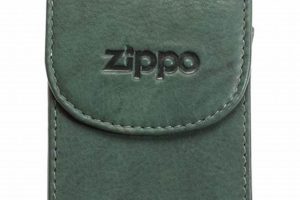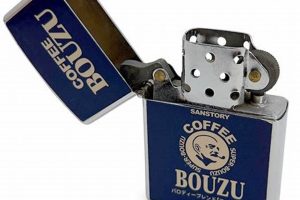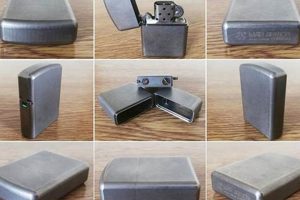Crafting a protective and stylish lighter case from leather involves several key steps, from selecting appropriate materials and tools to precise cutting, shaping, and stitching. The process typically begins with a pattern tailored to the lighter’s dimensions, ensuring a snug fit. Leather pieces are then carefully cut and edges are often beveled and burnished for a refined finish. Stitching, typically using a saddle stitch for durability, joins the pieces to form the case, which might also incorporate features like a belt loop or snap closure. Finally, the leather can be treated with conditioners or waxes for protection and enhanced aesthetics. An example would be creating a case from vegetable-tanned leather, using a diamond-shaped pattern, and securing it with a hand-stitched saddle stitch.
This craft offers both practical and aesthetic advantages. A custom-made leather case safeguards a lighter from scratches and impacts, prolonging its lifespan. It also provides an opportunity for personalized expression, allowing for customization through tooling, dyeing, or the addition of decorative elements. Historically, carrying personal items in handcrafted cases signifies both practicality and a degree of craftsmanship, reflecting a value placed on durability and personalization. Leather, with its durability and malleability, has been a preferred material for such cases for centuries.
This article will delve deeper into the specific techniques and materials required for this project. It will cover topics including leather selection, pattern design, tooling options, stitching methods, and finishing techniques, equipping readers with the knowledge to produce a high-quality, durable, and personalized lighter case.
Tips for Crafting a Leather Zippo Lighter Case
The following tips provide guidance for constructing a durable and aesthetically pleasing lighter case.
Tip 1: Leather Selection: Opt for vegetable-tanned leather for its durability and ability to be molded and tooled. Consider thickness; 2-3 oz leather offers a balance between protection and flexibility. Ensure the chosen leather is free from major blemishes or inconsistencies.
Tip 2: Precise Pattern Cutting: Accurate pattern cutting is crucial for a well-fitting case. Use a sharp blade and a sturdy cutting surface. A metal ruler ensures straight lines. Consider adding a small margin to the pattern for stitching allowance.
Tip 3: Edge Finishing: Beveling and burnishing the edges of the leather pieces adds a professional touch and prevents fraying. Specialized edge bevelers and burnishing tools create smooth, polished edges.
Tip 4: Saddle Stitch Mastery: The saddle stitch, executed with two needles and a single thread, provides exceptional strength and durability. Practice this technique on scrap leather before working on the final pieces. Maintain consistent stitch spacing and tension.
Tip 5: Hardware Selection: If incorporating hardware like snaps or rivets, choose high-quality materials that complement the leather. Ensure proper installation to prevent loosening or damage.
Tip 6: Leather Treatment and Finishing: Conditioning the leather after construction helps protect it from moisture and wear. Leather waxes or oils can enhance the color and provide a polished appearance. Test any finish on a scrap piece first to ensure compatibility.
Tip 7: Pattern Design Considerations: A well-designed pattern considers the lighter’s dimensions, desired features, and the leather’s properties. Allow for flexibility in the design for ease of insertion and removal of the lighter.
By adhering to these tips, one can achieve professional-grade results, creating a lighter case that is both functional and visually appealing. Careful attention to detail during each stage of the process ensures a finished product that reflects quality craftsmanship.
This information provides a foundation for creating a personalized and durable lighter case. The following section will conclude the article with final thoughts and considerations.
1. Pattern Design
Pattern design represents a foundational element in crafting a leather Zippo lighter case. A well-conceived pattern dictates the final form, fit, and functionality of the case. Careful consideration of the lighter’s dimensions, desired features (e.g., belt loops, snap closures), and the chosen leather’s thickness are crucial during pattern development. A precisely drafted pattern ensures efficient material usage and minimizes the risk of errors during the cutting and assembly stages. For instance, a pattern that accurately accounts for the lighter’s depth prevents a loose fit, while appropriate seam allowances ensure clean, durable stitching. Conversely, an ill-fitting pattern can lead to material wastage, a poorly functioning case, and a compromised aesthetic outcome.
Practical applications of effective pattern design are readily apparent. Consider a case designed with a curved flap to accommodate the lighter’s hinge mechanism seamlessly. This design choice, reflected in the pattern, not only enhances functionality but also contributes to the overall aesthetic. Another example is a pattern incorporating precise cutouts for accessing the lighter’s flint wheel, eliminating the need to remove the lighter from the case for refilling. Such design considerations, originating in the pattern stage, demonstrate the direct impact of pattern design on both the practical use and final appearance of the finished product.
In summary, pattern design stands as a critical initial step. Its influence permeates the entire construction process, affecting the fit, function, and aesthetic appeal of the final lighter case. Mastery of pattern design principles empowers the craftsperson to translate a conceptual design into a tangible, well-executed final piece. Challenges in pattern design, such as accurately accounting for leather thickness and three-dimensional shaping, are best addressed through careful planning, precise measurements, and iterative prototyping. This meticulous approach to pattern development directly contributes to a successful outcome in crafting a high-quality, functional, and visually appealing leather Zippo lighter case.
2. Leather Selection
Leather selection significantly influences the final quality, durability, and aesthetic of a Zippo lighter case. The type of leather chosen directly impacts the case’s ability to protect the lighter, its lifespan, and its overall appearance. Vegetable-tanned leather, known for its firmness and ability to hold its shape, is often preferred for this application. Its dense fibers provide robust protection against impacts and scratches. Choosing a thinner, more pliable leather, such as chrome-tanned, might result in a softer case but compromise its protective qualities. Full-grain leather, representing the outermost layer of the hide, offers superior durability and develops a rich patina over time, making it a premium choice. Conversely, corrected-grain or split-grain leathers, though more economical, lack the same resilience and longevity. This choice represents a pivotal step in the crafting process. For instance, a case constructed from high-quality, vegetable-tanned full-grain leather will offer superior protection and develop a desirable patina with use, while a case made from thin, corrected-grain leather might wear quickly and offer inadequate protection.
The thickness of the leather also plays a crucial role. A thicker leather provides greater protection but can make the case bulky and difficult to use. A thinner leather offers greater flexibility and a slimmer profile, but might not provide adequate protection against drops or impacts. The intended use of the case should inform the choice of leather thickness. A case designed for everyday carry might benefit from slightly thicker leather for added protection, while a case intended for occasional use might prioritize a slimmer profile achieved with thinner leather. Selecting the appropriate leather and thickness requires careful consideration of the desired balance between protection, aesthetics, and practicality. For example, a field-use case might benefit from thicker, more robust leather, while a dress case might prioritize a thinner, more elegant profile.
In conclusion, careful leather selection is paramount to creating a successful Zippo lighter case. Choosing the right type and thickness of leather directly impacts the case’s durability, functionality, and aesthetic appeal. Understanding the properties of different leather types empowers informed decision-making, enabling the creation of a case that not only protects the lighter effectively but also reflects individual preferences and intended use. Challenges in leather selection, such as balancing durability with aesthetics and cost, highlight the importance of a well-defined project scope prior to material acquisition. This approach ensures the chosen leather aligns with the intended outcome, maximizing the likelihood of a satisfying and functional final product.
3. Cutting Techniques
Precision in cutting techniques is paramount when crafting a leather Zippo lighter case. Accurate cuts determine the final fit, finish, and overall quality of the case. Improper cutting can lead to ill-fitting components, compromised structural integrity, and an unprofessional appearance. This section explores essential cutting techniques relevant to this craft.
- Straight Line Cutting:
Achieving perfectly straight lines is fundamental for clean edges and precise assembly. Employing a sharp utility knife or leather shears in conjunction with a metal ruler ensures accuracy. Deviation from straight lines can result in misaligned pieces and a compromised final product. A sharp blade minimizes ragged edges, reducing the need for extensive finishing work. For example, cutting the main body pieces of the lighter case requires precise straight lines to ensure proper alignment during stitching.
- Curved Cuts:
Certain designs might incorporate curved elements, demanding precise control over the cutting implement. A sharp, swiveling blade or specialized leather scissors facilitates accurate curved cuts. Examples include creating a rounded flap closure or incorporating decorative curves into the case design. Smooth, controlled cuts contribute to a professional aesthetic. Inconsistent or jagged curves detract from the overall quality of the finished piece. Practice on scrap leather helps refine technique and build confidence before working on the final piece.
- Beveling:
Beveling, the process of thinning the edges of leather, prepares them for stitching and enhances the final appearance. A specialized beveling tool creates a consistent angle along the edge, reducing bulk and improving the lie of the finished seam. Proper beveling contributes to a more refined, professional look. Uneven beveling can lead to unsightly seams and compromise the structural integrity of the case. Skiving, a related technique, thins down specific areas of the leather, often used where pieces overlap, like at a closure.
- Punching and Slot Cutting:
Creating precise holes and slots for stitching or hardware requires specialized tools. Rotary punches or chisel punches create clean, consistent holes. Slot punches create elongated openings for straps or belt loops. Accurate punching ensures proper alignment of hardware and contributes to a secure, professional finish. Inconsistent or poorly placed holes can weaken the leather and compromise the functionality of closures or attachments. Careful measurement and marking prior to punching are essential for achieving optimal results.
Mastering these cutting techniques is crucial for constructing a well-made leather Zippo lighter case. Precise and clean cuts ensure proper fit, enhance the aesthetic appeal, and contribute to the overall durability of the finished product. Consistent application of these techniques, combined with careful material selection and meticulous assembly, elevates the craft from a simple project to a demonstration of skilled workmanship.
4. Stitching Methods
Stitching methods represent a critical element in constructing a durable and aesthetically pleasing leather Zippo lighter case. The chosen stitching method directly impacts the case’s structural integrity, longevity, and overall appearance. A strong, well-executed stitch ensures the leather pieces remain securely joined, while a poorly executed or inappropriate stitch can lead to premature wear, seam separation, and a compromised aesthetic. The saddle stitch, a time-honored technique utilizing two needles and a single thread, is often favored for leatherwork due to its inherent strength and durability. This hand-stitching method creates a lock stitch that interlocks the thread within the leather, preventing unraveling even if one stitch is compromised. Alternative methods, such as machine stitching or using a single-needle hand stitch, might offer increased speed but often compromise strength and longevity, particularly in applications subject to stress and wear like a lighter case. Consider a case subjected to daily use: a saddle-stitched seam will resist wear and maintain its integrity significantly longer than a machine-stitched seam or a simpler hand-stitched seam. This resilience stems from the saddle stitch’s interlocking nature, which distributes stress across multiple fibers and prevents unraveling.
The choice of stitching method influences not only the structural integrity but also the aesthetic of the finished case. A neatly executed saddle stitch, with its evenly spaced and precisely angled stitches, adds a touch of handcrafted elegance and signals attention to detail. Conversely, uneven or hastily executed stitching, regardless of the method employed, detracts from the overall appearance and can suggest a lack of craftsmanship. The thread itself contributes to both the structural and aesthetic dimensions. A strong, waxed linen thread complements the saddle stitch, enhancing its durability and providing visual appeal. A thinner, weaker thread, even with a robust stitching method, might break under stress, compromising the integrity of the case. For instance, a lighter case intended for rugged outdoor use would benefit from a heavy-duty waxed linen thread stitched with the saddle stitch method, ensuring maximum durability and resilience against wear and tear.
In summary, the selection and execution of the stitching method play a pivotal role in determining the longevity, durability, and aesthetic appeal of a leather Zippo lighter case. The saddle stitch, with its inherent strength and classic appeal, often represents the optimal choice for this type of project, particularly when combined with appropriate thread selection. While alternative methods exist, they often compromise the long-term durability and aesthetic quality of the finished product. Challenges in achieving consistent, evenly spaced saddle stitching underscore the importance of practice and patience in mastering this fundamental leatherworking technique. This meticulous approach to stitching, coupled with careful material selection and precise cutting, culminates in a lighter case that not only functions effectively but also stands as a testament to quality craftsmanship.
5. Edge Finishing
Edge finishing represents a crucial step in crafting a leather Zippo lighter case, significantly impacting its final appearance, durability, and professional quality. Properly finished edges elevate the case’s aesthetic appeal, protect the leather from wear and moisture, and contribute to a refined, polished look. Neglecting edge finishing can result in a frayed, unfinished appearance, diminishing the overall quality and longevity of the case.
- Beveling:
Beveling involves skiving or sanding the edges of the leather at an angle, reducing thickness and creating a smoother, more comfortable feel. This process prepares the edges for subsequent finishing steps and prevents the leather from becoming overly bulky at the seams. Beveling also enhances the visual appeal of the finished case by creating a subtle, elegant contour along the edges. A well-beveled edge contributes to a more comfortable grip and prevents the edges from digging into the hand during use. Without beveling, the edges of the case might feel sharp or uncomfortable and appear thick and unfinished.
- Edge Painting:
Edge paint, specifically designed for leather, seals and protects the beveled edges from moisture and wear. It also enhances the color and creates a polished, professional look. Edge paint prevents the leather from absorbing moisture, which can lead to discoloration and deterioration. It also helps to resist abrasion and fraying, prolonging the lifespan of the case. Applying edge paint requires a steady hand and even pressure to achieve a smooth, consistent finish. Several coats might be necessary for optimal coverage and color saturation. For example, a black edge paint on a brown leather case can create a visually striking contrast and a refined appearance.
- Burnishing:
Burnishing involves rubbing the edges of the leather with a specialized tool or canvas cloth to smooth and polish the surface. This process compresses the leather fibers, creating a hard, smooth finish that resists fraying and wear. Burnishing further enhances the professional look of the case by adding a subtle sheen to the edges. It also improves the feel of the edges, making them smooth and comfortable to the touch. Burnishing can be done with or without the application of edge paint. When used in conjunction with edge paint, burnishing creates a highly polished, almost glassy finish. For instance, burnishing the edges of a lighter case after applying edge paint creates a smooth, sealed edge resistant to moisture and wear, enhancing the case’s durability and aesthetic appeal.
- Sanding:
Sanding, typically done with fine-grit sandpaper, smooths any imperfections or irregularities on the edges before applying other finishing techniques. It refines the shape of the bevel and prepares the leather for edge paint or burnishing. Sanding is particularly important for achieving a smooth, even finish when working with thicker leathers or when a highly polished edge is desired. Over-sanding, however, can thin the leather excessively, compromising its durability. Sanding should be done with care, using light pressure and progressively finer grits of sandpaper to achieve the desired smoothness without damaging the leather.
These edge finishing techniques, when executed meticulously, contribute significantly to the overall quality and aesthetic of a handcrafted leather Zippo lighter case. They not only protect the leather from wear and tear, extending the lifespan of the case, but also elevate its visual appeal, transforming a functional item into a piece of finely crafted leatherwork. The combination of beveling, edge painting, burnishing, and sanding creates a refined, polished look that distinguishes a handcrafted case from a mass-produced one. By mastering these techniques, one elevates the quality of the finished product, demonstrating attention to detail and a commitment to craftsmanship. The finished edges, smooth, polished, and resistant to wear, reflect the care and skill invested in the crafting process, making the case not just a functional object, but a testament to the art of leatherworking.
6. Hardware/Embellishments
Hardware and embellishments play a significant role in the functionality and aesthetics of a handcrafted leather Zippo lighter case. These elements can enhance usability, personalize the design, and elevate the overall craftsmanship. Careful selection and application of hardware and embellishments contribute to a finished product that reflects both functionality and individual style. This section explores various options and their impact on the final product.
- Functional Hardware:
Functional hardware serves a practical purpose, enhancing the usability of the lighter case. Snaps, for instance, provide a secure closure, ensuring the lighter remains protected within the case. Belt loops or clips offer convenient carrying options, allowing the case to be attached to a belt or pocket. The choice of hardware should consider the intended use of the case and the overall design aesthetic. A sturdy snap closure, for example, ensures the lighter remains securely within the case during daily carry, while a discreet belt loop allows for convenient access without sacrificing portability. Selecting appropriate hardware enhances both the functionality and longevity of the case.
- Decorative Embellishments:
Decorative embellishments personalize the lighter case and reflect individual style. Tooling, the process of impressing designs into the leather, adds a unique, handcrafted touch. Conchos, metal ornaments often featuring decorative motifs, can be incorporated into the design for added flair. Dyeing the leather in various colors or applying antique finishes further customizes the appearance. These embellishments transform a functional case into a personalized accessory. For example, tooling a floral design onto the flap of the case adds a touch of artistry, while a strategically placed concho complements the overall aesthetic. The choice of embellishments reflects individual preferences and allows for creative expression.
- Material Considerations:
The materials used for hardware and embellishments influence the overall quality and aesthetic of the lighter case. High-quality brass or nickel-plated snaps offer durability and resistance to corrosion. Solid metal conchos, rather than plated ones, provide lasting value and enhance the perceived quality of the case. Selecting materials that complement the chosen leather type is essential for creating a cohesive and visually appealing final product. For instance, brass hardware complements the warm tones of vegetable-tanned leather, while silver-toned hardware might pair well with cooler-toned leathers. Material selection plays a key role in ensuring the longevity and aesthetic harmony of the finished piece.
- Application Techniques:
Proper application techniques are crucial for ensuring the secure and aesthetically pleasing attachment of hardware and embellishments. Snaps should be set using appropriate tools to prevent loosening or damage to the leather. Conchos and other decorative elements should be securely fastened using rivets or strong adhesive. Precise placement and careful execution enhance the professional appearance of the finished case. For example, unevenly spaced rivets or poorly set snaps detract from the overall quality. Mastering proper application techniques ensures the longevity and visual appeal of the hardware and embellishments, contributing to a well-crafted and aesthetically pleasing final product.
The choice and application of hardware and embellishments significantly impact the functionality, personalization, and perceived quality of a leather Zippo lighter case. Selecting appropriate hardware enhances usability and ensures the longevity of the case. Decorative embellishments allow for creative expression and personalize the design. Careful consideration of materials and meticulous application techniques contribute to a professionally finished product that reflects both practicality and individual style. These seemingly small details elevate the craft, transforming a simple functional item into a personalized accessory that reflects the maker’s skill and attention to detail.
Frequently Asked Questions
This section addresses common inquiries regarding the construction of leather Zippo lighter cases.
Question 1: What type of leather is best suited for this project?
Vegetable-tanned leather is generally recommended for its durability, ability to hold its shape, and compatibility with tooling and dyeing techniques. Full-grain vegetable-tanned leather offers the highest quality and durability.
Question 2: What thickness of leather should be used?
Leather thickness is typically measured in ounces. A 2-3 oz leather provides a good balance between durability and flexibility for lighter cases. Thicker leather offers more protection but can make the case bulky.
Question 3: What tools are essential for this project?
Essential tools include a sharp utility knife or leather shears, a metal ruler, a stitching groover, leather needles, waxed thread, an edge beveler, and an edge slicker. Optional tools include a stitching pony, leather mallet, and various stamping tools.
Question 4: What stitching method is recommended for maximum durability?
The saddle stitch, executed by hand with two needles and a single thread, provides exceptional strength and durability. It creates an interlocking stitch that resists unraveling.
Question 5: How can the edges of the leather be finished professionally?
Professional edge finishing involves beveling the edges, applying edge paint, and burnishing with a slicker or canvas cloth. This process creates a smooth, polished, and durable edge.
Question 6: What options exist for personalizing the lighter case?
Personalization options include tooling designs into the leather, adding decorative conchos or rivets, dyeing the leather, and applying antique finishes. These options allow for creative expression and customization.
Careful consideration of these frequently asked questions equips individuals with the knowledge to approach the project with confidence and achieve professional-quality results.
This concludes the frequently asked questions section. The following section will offer concluding remarks.
Conclusion
Crafting a leather Zippo lighter case requires a multifaceted approach, encompassing careful material selection, precise pattern cutting, meticulous stitching, and refined finishing techniques. Each stage contributes significantly to the final product’s functionality, durability, and aesthetic appeal. From the initial pattern design to the final burnishing of the edges, attention to detail remains paramount. The choice of leather, the precision of the cuts, the strength of the stitching, and the finishing of the edges all contribute to the creation of a well-crafted and durable case. Understanding the nuances of each step empowers the craftsperson to produce a high-quality, functional, and aesthetically pleasing lighter case that reflects both skill and attention to detail.
The creation of a handcrafted leather lighter case offers a tangible connection to traditional craftsmanship. This process allows for personalized expression and the development of valuable skills. The resulting piece represents not merely a functional object but a testament to the enduring appeal of handcrafted goods and the satisfaction derived from creating something both useful and beautiful. The dedication to precision and the attention to detail inherent in this craft contribute to a deeper appreciation for the enduring qualities of handcrafted items. This pursuit encourages further exploration of leatherworking techniques and the creation of personalized, enduring pieces.







